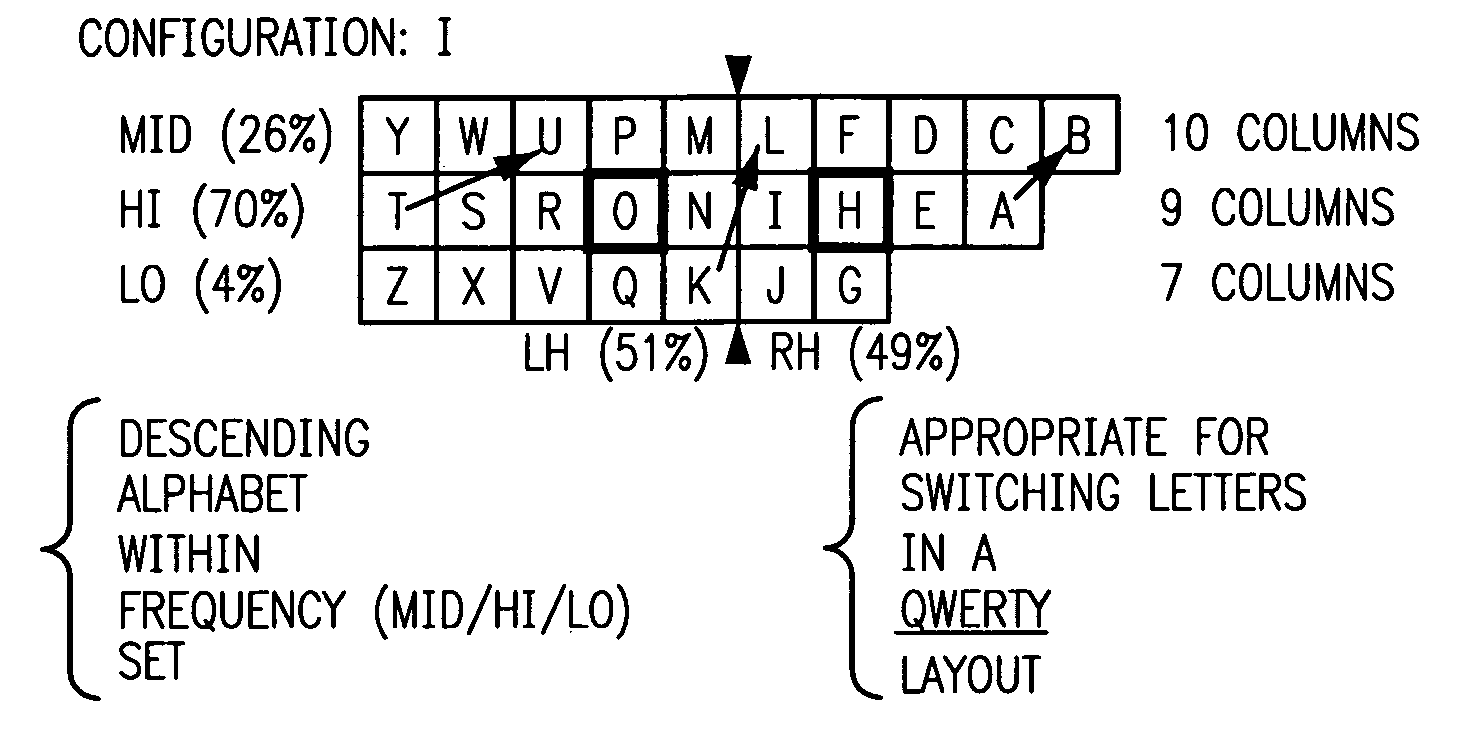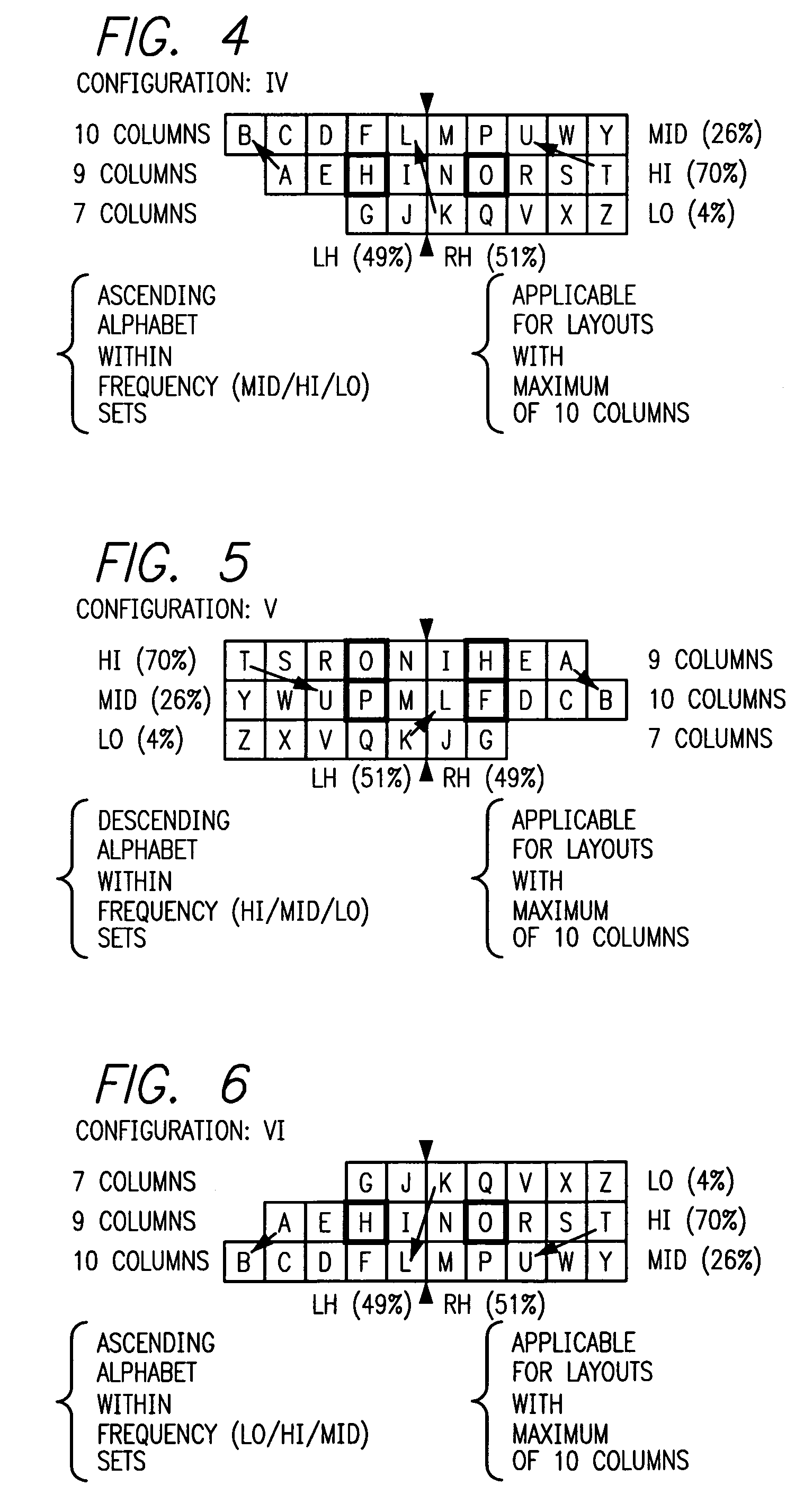Keyboard configuration system
a keyboard configuration and keyboard technology, applied in the field of keyboards, can solve the problems of keyboards that are difficult to learn, typewriters that often jam, typewriting process to stop, etc., and achieve the effect of convenient use and efficient and methodical us
- Summary
- Abstract
- Description
- Claims
- Application Information
AI Technical Summary
Benefits of technology
Problems solved by technology
Method used
Image
Examples
case number 92
[0106]Case number 92 is the least optimized of the 96 cases. Evaluation is performed on 25 pairs of successive numerical equivalent values, which results in a gauge of the case's optimization or lack thereof. Demerit scores are displayed in the case exhibit next to the higher of successive values for a pair. In case number 92, the pairs 01 to 02 (A to B), 13 to 14 (M to N), and 15 to 16 (O to P) receive no demerits for lateral movement in the same position. The pairs 02 to 03 (B to C), 03 to 04 (C to D), 06 to 07 (F to G), 08 to 09 (H to I), 10 to 11 (J to K), 12 to 13 (L to M), 14 to 15 (N to O), 18 to 19 (R to S), and 19 to 20 (S to T) receive no demerits for forward movement of one position. The pair 04 to 05 (D to E) receives one demerit for backward movement of one position. The pairs 07 to 08 (G to H) and 20 to 21 (T to U) receive two demerits for backward movement of two positions. The pair 09 to 10 (I to J) receives three demerits for backward movement of three positions. Th...
case numbers 53 and 61
[0109 are tied for the most optimized of the 96 cases. Each case has no demerits for excess forward movement. Each case has a total of four demerits for backward movement. In both cases, the pair 20 to 21 receives two demerits for backward movement. In both cases, the pair 11 to 12 receives one demerit for backward movement. In case 53 all lists end in position 09, and the pair 02 to 03 receives one demerit for backward movement. In case 61 all lists end in position 10, and the pair 01 to 02 receives one demerit for backward movement.
[0110]Table 5 (case numbers by total demerits) has a one line record for each of the 96 cases. Backward demerits and excess forward demerits are displayed. These two demerit values are summed, and the total demerits result is displayed for each case. All 96 sets in Table 5 are sorted by case number within total demerits value. Case number 92 is listed at the end of Table 5. The largest total demerits value of 39 is the sum of 24 backward demerits and 15...
case numbers 101 through 49
[01506 cover four additional applications, which correspond to different letter-usage frequencies that have been determined for the English alphabet and language.
[0151]The 96 case numbers 101 through 196 for the second application use data from the book “The Code Breakers” by David Kahn. The letter frequency order from this source in descending sequence E, T, A, O, N, I, R, S, H, D, L, U, C, M, P, F, Y, W, G, B, V, J, K, Q, X, Z. This is a different frequency sequence than the ones used for Cases 1–96 arising from Gaines / Meaker.
[0152]The 96 case numbers 201 through 296 for the third application use data from the book “Secret And Urgent: The Story Of Codes And Ciphers” by Fletcher Pratt. The letter frequency order from this source in descending sequence: E, T, A, O, N, R, I, S, H, D, L, F, C, M, U, G, Y, P, W, B, V, K, X, J, Q, Z.
[0153]The 96 case numbers 301 through 396 for the fourth application use data from the book “Cryptography” by Laurence D. Smith. The letter frequency order ...
PUM
 Login to View More
Login to View More Abstract
Description
Claims
Application Information
 Login to View More
Login to View More - R&D
- Intellectual Property
- Life Sciences
- Materials
- Tech Scout
- Unparalleled Data Quality
- Higher Quality Content
- 60% Fewer Hallucinations
Browse by: Latest US Patents, China's latest patents, Technical Efficacy Thesaurus, Application Domain, Technology Topic, Popular Technical Reports.
© 2025 PatSnap. All rights reserved.Legal|Privacy policy|Modern Slavery Act Transparency Statement|Sitemap|About US| Contact US: help@patsnap.com



